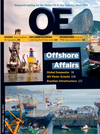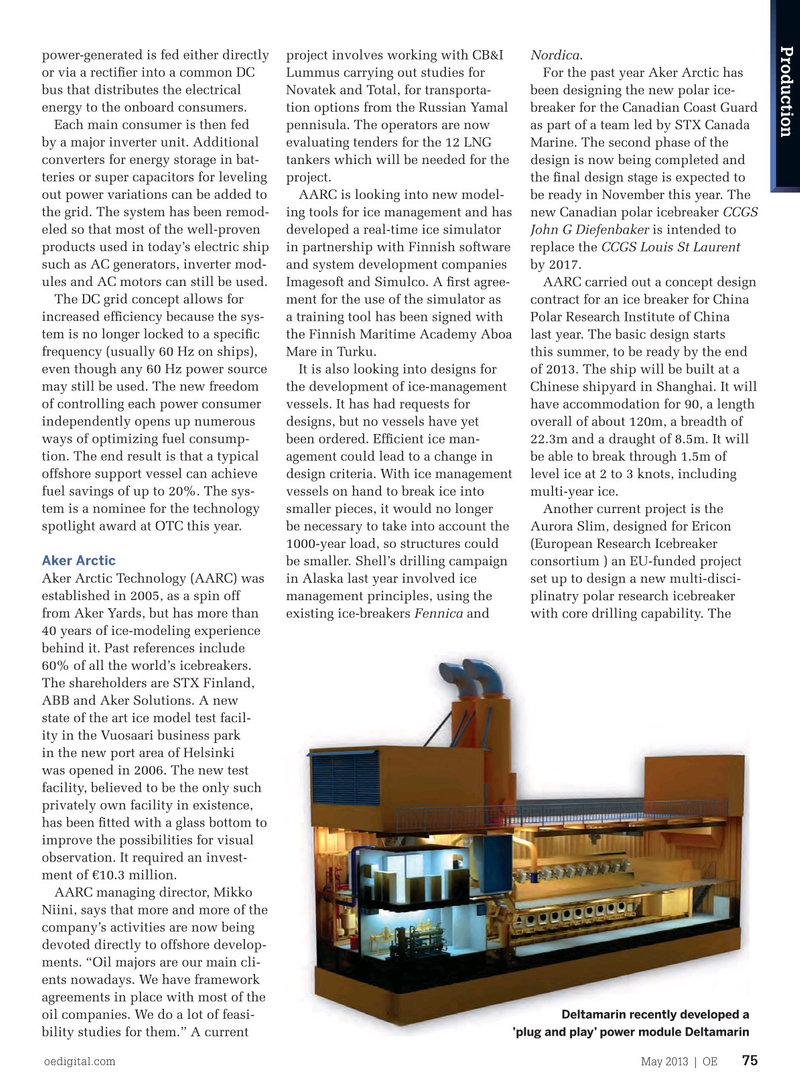
Page 73: of Offshore Engineer Magazine (May/Jun 2013)
Read this page in Pdf, Flash or Html5 edition of May/Jun 2013 Offshore Engineer Magazine
Production power-generated is fed either directly project involves working with CB&I Nordica.
or via a rectifer into a common DC Lummus carrying out studies for For the past year Aker Arctic has bus that distributes the electrical Novatek and Total, for transporta- been designing the new polar ice- energy to the onboard consumers. tion options from the Russian Yamal breaker for the Canadian Coast Guard
Each main consumer is then fed pennisula. The operators are now as part of a team led by STX Canada by a major inverter unit. Additional evaluating tenders for the 12 LNG Marine. The second phase of the converters for energy storage in bat- tankers which will be needed for the design is now being completed and teries or super capacitors for leveling project. the fnal design stage is expected to out power variations can be added to AARC is looking into new model- be ready in November this year. The the grid. The system has been remod- ing tools for ice management and has new Canadian polar icebreaker CCGS eled so that most of the well-proven developed a real-time ice simulator John G Diefenbaker is intended to products used in today’s electric ship in partnership with Finnish software replace the CCGS Louis St Laurent such as AC generators, inverter mod- and system development companies by 2017.
ules and AC motors can still be used. Imagesoft and Simulco. A frst agree- AARC carried out a concept design
The DC grid concept allows for ment for the use of the simulator as contract for an ice breaker for China increased effciency because the sys- a training tool has been signed with Polar Research Institute of China tem is no longer locked to a specifc the Finnish Maritime Academy Aboa last year. The basic design starts frequency (usually 60 Hz on ships), Mare in Turku. this summer, to be ready by the end even though any 60 Hz power source It is also looking into designs for of 2013. The ship will be built at a may still be used. The new freedom the development of ice-management Chinese shipyard in Shanghai. It will of controlling each power consumer vessels. It has had requests for have accommodation for 90, a length independently opens up numerous designs, but no vessels have yet overall of about 120m, a breadth of ways of optimizing fuel consump- been ordered. Effcient ice man- 22.3m and a draught of 8.5m. It will tion. The end result is that a typical agement could lead to a change in be able to break through 1.5m of offshore support vessel can achieve design criteria. With ice management level ice at 2 to 3 knots, including fuel savings of up to 20%. The sys- vessels on hand to break ice into multi-year ice.
tem is a nominee for the technology smaller pieces, it would no longer Another current project is the spotlight award at OTC this year. be necessary to take into account the Aurora Slim, designed for Ericon 1000-year load, so structures could (European Research Icebreaker
Aker Arctic be smaller. Shell’s drilling campaign consortium ) an EU-funded project
Aker Arctic Technology (AARC) was in Alaska last year involved ice set up to design a new multi-disci- established in 2005, as a spin off management principles, using the plinatry polar research icebreaker from Aker Yards, but has more than existing ice-breakers Fennica and with core drilling capability. The 40 years of ice-modeling experience behind it. Past references include 60% of all the world’s icebreakers.
The shareholders are STX Finland,
ABB and Aker Solutions. A new state of the art ice model test facil- ity in the Vuosaari business park in the new port area of Helsinki was opened in 2006. The new test facility, believed to be the only such privately own facility in existence, has been ftted with a glass bottom to improve the possibilities for visual observation. It required an invest- ment of €10.3 million.
AARC managing director, Mikko
Niini, says that more and more of the company’s activities are now being devoted directly to offshore develop- ments. “Oil majors are our main cli- ents nowadays. We have framework agreements in place with most of the
Deltamarin recently developed a oil companies. We do a lot of feasi- ’plug and play’ power module Deltamarin bility studies for them.” A current oedigital.com May 2013 | OE 75 0513OE_prod_ops3_chesshyre.indd 75 4/22/13 5:06 PM

 72
72

 74
74